

Canon Rebel T5i (700D) and Sl1 (100D) - A closer look and preview
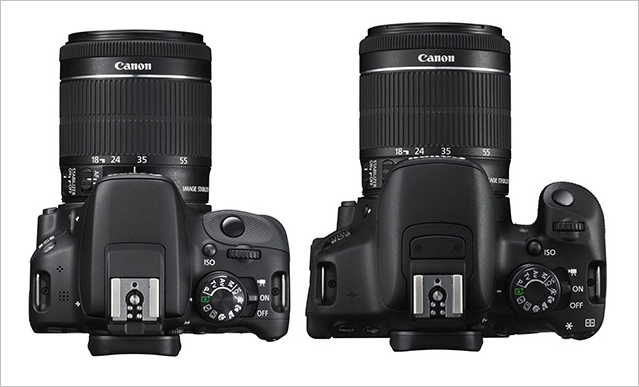
LEFT: New EOS Rebel SL1 RIGHT: New EOS Rebel T5i
Now that the initial buzz about Canon's two new Digital Rebel bodies has died down(?) I thought it might be good to take a closer look at the new Canon EOS Digital Rebel T5i (700D) and SL1 (100D). Well the first and most obvious difference is size as shown above. The new Rebel SL1 is indeed smaller in every dimension than the T5i, although part of that reduction in size is the elimination of the T5i's grip in the SL1. Whether this is important for you depends on how big your hands are I guess. For me (male, 6ft) the EOS Rebel series bodies are already a little small to grip comfortably, but I've heard comments from those with smaller hands that the larger EOS bodies (60D, 7D) are too large and so a smaller body might well be easier for them to hold.
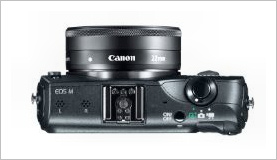
EOS-M with 22mm STM lens
However as you can also see from the images above, once you mount most lenses on either body, the lens pretty much dominates the overall size. To make much difference there you'd need (a) a much thinner body with a shorter flange to sensor distance and (b) a much smaller lens designed for that shorter flange to sensor distance. That's pretty much a description of the mirrorless EOS-M and EOS-M series lenses.
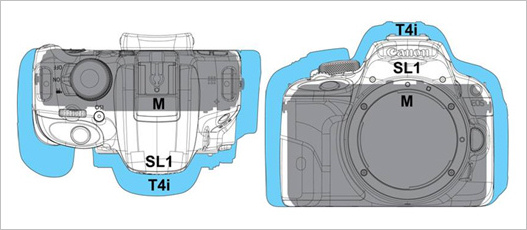
As you can see from the above illustration, getting rid of the pentamirror(prism) housing and building a system with a shorter flange to sensor distance makes a big difference in the overall size (and weight) of the camera. So while the SL1 may be one of the samllest and lightest DSLR in current production, and certainly the smallest current APS-C DSLR, it's still quite large when compared with a mirrorless camera.
Of course not everyone wants a mirrorless camera. You give up the bright, real-time, optical viewfinder for one thing. That's very nice to have unless you really like holding the camera out at arms length and composing on the LCD screen. A conventional DSLR also accepts all EF and EF-S series lenses too, whereas the EOS-M requires an adapter. Of course the native EOS-M lenses are smaller, but then again you only have a choice of two.
Canon Rebel T5i and SL1: Features

When it comes to features the T5i and Sl1 have a few obvious differences. Perhaps the most obvious external difference apart from size is that the T5i has a tilt and swivel, fold-out LCD screen which is great for low angle and overhead shots and can make shooting video a lot easier. The SL1 has a fixed LCD, probably because of the small size that Canon were aiming for, plus a fixed LCD is cheaper.
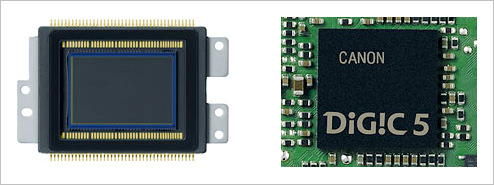
On the other hand the SL1 has a new sensor with better Hybrid AF Hybrid CMOS AF II). The new sensor has phase sensitive pixels distributed over a wider area of the sensor. These phase sensitive pixels enable faster and better continuous AF while shooting in video mode. That also assist in Live View Still mode too. This sensor isn't used in the T5i. Although Canon don't exactly say so, it seems the T5i inherits its sensor from the T4i. Both the T5i and the SL1 inherit the Digic V processor of the T4i. The new Powershot SX-280 now has a Digic VI processor, but it didn't make it into either new DSLR.
When it comes to audio recording, the T5i has a built in stereo microphone, while the SL1's built in microphone is mono. Both can accept an external microphone and both allow for manual control of the audio level (as well as auto control of course).
When it comes to continuous shooting at first the cameras seem pretty similar. The T5i can do 5 frames/sec while the SL1 is almost as fast at 4 frames/sec. With a fast 8GB SDHC card the T5i's buffer can hold 22 JPEG or 6 RAW files, while that of the SL1 can hold 28 JPEGs or 7 RAW files. A little better, but not a huge difference. However with a UHS-1 enabled card the T5i's buffer goes up to 30 JPEGs and still only 6 RAW, while the SL1 with a UHS-1 enabled card can shoot (by Canon's counting) 1140 JPEGs - though still only 8 RAW files. So the situation seems to be that the T5i will shoot JPEGs faster (5fps) for around 6 seconds before the buffer fills, while the SLI shoots a little slower (4fps), but can shoot for around 4 minutes and 45 seconds at that speed! Almost enough for a short (if jerky) movie!
I guess the slightly slower shooting speed of the SL1 is just slow enough to allow the image to be converted to JPEG and written out to memory with a UHS-1 card, while the T5i is shooting just a little too fast to do this. Both cameras use the same DIGIC V processor. Seems like this is a case of "less is sometimes more".
AF is another area in which there is a significant difference. While both cameras have 9 AF zones arranges in the same pattern on the SL1 on the center zone is a cross sensor (at f5.6). At f2.8 the center zone can act as a high accuracy vertical line sensor). With the T5i, all 9 AF zones have cross type sensors at f5.6 and the center zone is a diagonal cross type with high accuracy at f2.8. This should give the Rebel T5i and AF advantage over the Rebel SL1.
There's a small difference in the optical viewfinder of the T5i and SL1. Both have 95% coverage but the SL1 has 0.87x magnification while the T5i is the same as the T4i at 0.85x. That's a small enough difference that unless it was pointed out, most people probably wouldn't notice. For reference the 7D is 100% with 1x magnification and the 60D is 96% with 0.95x magnification.
Finally, the built in flash of the T5i can be used as an optical wireless master controller for external speedlites, while the built in flash on the SL1 does not have this capability.
Canon Rebel T5i and T4i
So while the Rebel T5i and SL1 have pretty clear differences, what about the T5i and T4i? Well, the differences here aren't quite so clear. Both the T4i and the T5i have a DIGIC V processor but new firmware in the T5i allows real time preview of some special effects when shooting in Live View mode. In terms of hardware and controls it appears that the major difference is that the mode control dial will now spin through 360 degrees on the T5i so you canget from the last option to the first in one click, whereas on the T4i there was a stop on rotation and to get to the first setting from the last you had to go back through all the intermediate options. The Sensor, AF system, metering system, shutter and continuous drive seem to be pretty much identical on the T5i and T4i as do the video modes and ISO range.
Overall, at least on paper, it seems like this is a minor upgrade rather than a major one, and I'm sure the T4i will soon disappear from Canon's product line. It's still there as of today (03/16/13) and probably will be until some time after the T5i actually starts shipping. That would leave the T3i as the next step down in the Rebel series.
Rebel T5i, T4i or SL1 - Which one to buy?
Good question. Between the SL1 and the T5i the T5i is the better camera if you don't care about continuous AF when shooting video. It has a better AF system, a faster frame rate and an articulating LCD, all of which are potentially useful. The SL1 has a new hybrid CMOS AF system which may give better focus tracking while shooting video. It's also smaller, but once you add a lens it's not all that much smaller. If smaller is important to you, take a look at the EOS-M too. The SL1 has a list price $649 for the body or for the SL1 with an 18-55 STM lens it's $799. The EOS-M with an 18-55 EF-M lens list price is $649 if you really want to go small. If you get the EOS-M with a 22mm STM lens for $549 it's even smaller and even cheaper

EOS-M with 22mm STM lens
The T5i vs the T4i is a more difficult question. The T5i is, I guess, slightly better, especially if you want a 360 degree rotating mode dial...However I'm sure the T4i will be selling at a discount. Right now you can get a T4i body for $648 or the T4i body with an 18-135 STM lens for $799. The new T5i will cost you $749 (T5i body only) or you can get a T5i with 18-135 STM lens for $1099. Right now the T4i sounds like a better deal, especially if you want the 18-135 STM lens with it. You'd save $300 and you can get it tomorrow rather than next month.
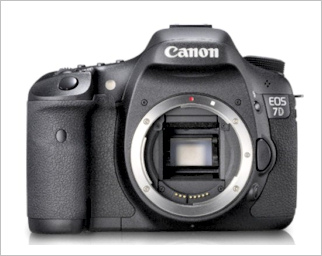
Checkout current prices
